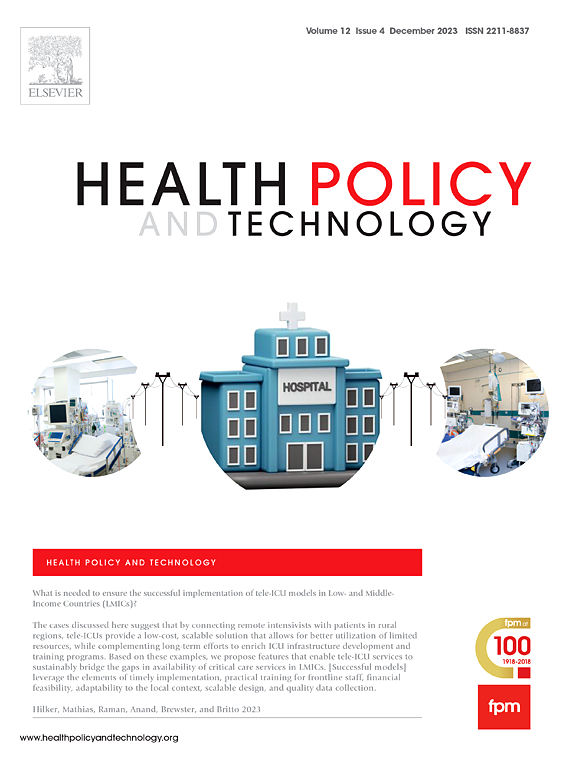Use of standardised measurement instruments and technology among Flemish physiotherapists: a cross-sectional online survey on current practices, attitudes, and barriers
IF 3.7
3区 医学
Q1 HEALTH POLICY & SERVICES
引用次数: 0
Abstract
Objectives
The aim of this study was to investigate the current levels of use and attitudes towards standardised measurement instruments and (rehabilitation) technology among physiotherapists in Flanders, Belgium.
Methods
This cross-sectional study used an open, online survey, accessible to physiotherapists working in Flanders.
Results
305 completed records were retrieved. Most respondents were female (73,8 %), had >11 years of clinical experience (54,1 %), and treated >10 patients per day (82,6 %). Less than half of the respondents (47,5 %) reported frequent use of standardised measurement instruments. Treating <15 patients per day and working in a rehabilitation centre were significantly associated with frequent use of measurement instruments. Lack of time and added value were most often reported as perceived barriers for systematic implementation. Regarding technology, respondents reported to lack sufficient knowledge (40,7 %), with 36,7 % using no technology in their clinical practice. Having between 3–10 years of clinical experience and frequently treating neurological disorders were significantly associated with an increased use of technology. Lack of finances, knowledge, time and skills were the most frequently perceived barriers to the use of (rehabilitation) technology.
Conclusion
Frequent use of measurement instruments among Flemish physiotherapists appears to be relatively low and one in ten frequently alters the standardised administration. Though attitudes toward (rehabilitation) technology are positive, its adoption in clinical practice appears to be relatively low. Identified barriers include financial constraints, lack of knowledge, time and skills.
Public interest summary
This study investigated how frequently physiotherapists in Flanders, Belgium use standardized measurement instruments (which assess a patient’s health status) and technology during their patients’ treatment. We surveyed 305 physiotherapists and found that fewer than half regularly use measurement instruments. Those who treated fewer patients and worked in rehabilitation centres used these tools more often. Lack of time was most often reported as a barrier for frequent use of measurement instruments.
Concerning (rehabilitation) technology, many physiotherapists felt they didn't have enough knowledge about such devices and more than one in three used no technology in their clinical practice. Those with 3–10 years of professional experience and those who often treated neurological disorders were more likely to use technology. The biggest barriers to using technology were lack of money, knowledge, time, and skills.
Stimulating the use of both standardised measurement instruments and rehabilitation technology could yield benefits for both therapist and patient.
佛兰德物理治疗师使用标准化测量仪器和技术:一项关于当前实践、态度和障碍的横断面在线调查
目的:本研究的目的是调查比利时法兰德斯地区物理治疗师对标准化测量仪器和(康复)技术的使用水平和态度。方法:本横断面研究采用开放的在线调查,对在法兰德斯工作的物理治疗师开放。结果共检索到305份完整记录。大多数应答者为女性(73,8%),具有11年临床经验(54,1%),每天治疗10例患者(82,6%)。不到一半的受访者(47.5%)报告经常使用标准化测量仪器。每天治疗15名患者并在康复中心工作与频繁使用测量仪器显著相关。缺乏时间和附加值最常被认为是阻碍系统实施的障碍。关于技术,受访者报告缺乏足够的知识(40.7%),36.7%的人在临床实践中没有使用技术。拥有3-10年的临床经验和经常治疗神经系统疾病与技术使用的增加显著相关。缺乏资金、知识、时间和技能是人们认为使用(康复)技术最常见的障碍。结论佛兰芒地区物理治疗师使用计量器具的频率较低,每10名物理治疗师中就有1人经常改变标准化给药方式。虽然对(康复)技术的态度是积极的,但其在临床实践中的采用似乎相对较低。确定的障碍包括资金限制、缺乏知识、时间和技能。本研究调查了比利时法兰德斯的物理治疗师在患者治疗期间使用标准化测量仪器(用于评估患者的健康状况)和技术的频率。我们调查了305名理疗师,发现只有不到一半的人经常使用测量仪器。那些治疗较少病人和在康复中心工作的人更经常使用这些工具。缺乏时间通常被认为是频繁使用测量仪器的障碍。关于(康复)技术,许多物理治疗师认为他们对这些设备的了解不够,超过三分之一的人在临床实践中没有使用任何技术。那些有3-10年专业经验和经常治疗神经系统疾病的人更有可能使用技术。使用技术的最大障碍是缺乏资金、知识、时间和技能。鼓励使用标准化测量仪器和康复技术可以为治疗师和患者带来好处。
本文章由计算机程序翻译,如有差异,请以英文原文为准。
求助全文
约1分钟内获得全文
求助全文
来源期刊

Health Policy and Technology
Medicine-Health Policy
CiteScore
9.20
自引率
3.30%
发文量
78
审稿时长
88 days
期刊介绍:
Health Policy and Technology (HPT), is the official journal of the Fellowship of Postgraduate Medicine (FPM), a cross-disciplinary journal, which focuses on past, present and future health policy and the role of technology in clinical and non-clinical national and international health environments.
HPT provides a further excellent way for the FPM to continue to make important national and international contributions to development of policy and practice within medicine and related disciplines. The aim of HPT is to publish relevant, timely and accessible articles and commentaries to support policy-makers, health professionals, health technology providers, patient groups and academia interested in health policy and technology.
Topics covered by HPT will include:
- Health technology, including drug discovery, diagnostics, medicines, devices, therapeutic delivery and eHealth systems
- Cross-national comparisons on health policy using evidence-based approaches
- National studies on health policy to determine the outcomes of technology-driven initiatives
- Cross-border eHealth including health tourism
- The digital divide in mobility, access and affordability of healthcare
- Health technology assessment (HTA) methods and tools for evaluating the effectiveness of clinical and non-clinical health technologies
- Health and eHealth indicators and benchmarks (measure/metrics) for understanding the adoption and diffusion of health technologies
- Health and eHealth models and frameworks to support policy-makers and other stakeholders in decision-making
- Stakeholder engagement with health technologies (clinical and patient/citizen buy-in)
- Regulation and health economics
 求助内容:
求助内容: 应助结果提醒方式:
应助结果提醒方式:


